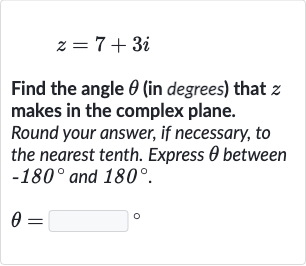Full solution
Q. Find the angle (in degrees) that makes in the complex plane. Round your answer, if necessary, to the nearest tenth. Express between and .
- Calculate Ratio: To find the angle that the complex number makes with the positive real axis in the complex plane, we use the argument of the complex number, which is the angle in polar coordinates. The argument can be found using the arctangent function, which gives the angle whose tangent is the ratio of the imaginary part to the real part of the complex number.
- Use Arctangent: Calculate the ratio of the imaginary part to the real part of . For , the imaginary part is and the real part is . So the ratio is .
- Perform Calculation: Use the arctangent function to find the angle. The arctangent of will give us the angle in radians. We need to convert this to degrees.
- Convert to Degrees: Perform the calculation using a calculator or a software tool that can compute arctangent values and convert radians to degrees. (rounded to the nearest tenth)
- Check Quadrant: Check the quadrant to ensure the angle is expressed between and . Since is in the first quadrant, where both real and imaginary parts are positive, the angle we found is already in the correct range.

